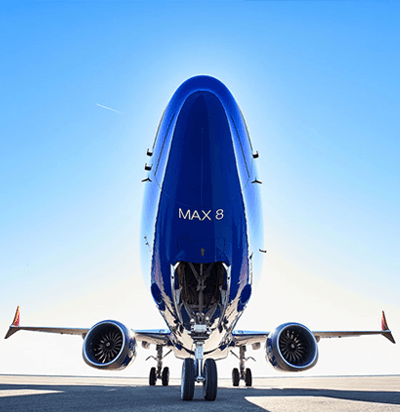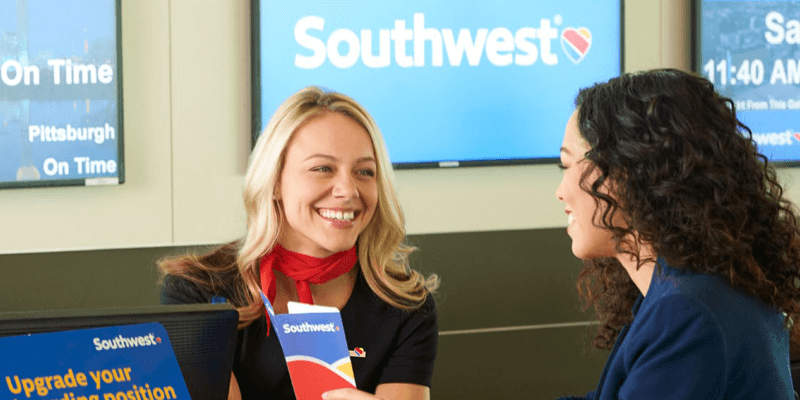
Southwest Airlines maintains on-time flights and optimises fleet performance with Tableau
Optimised on-time performance for 4,000 daily flights
Saved on fuel costs with improved flight planning
Scaled from 3 to 2,900 Tableau users in 4 years
With more than 700 aircraft operating at least 4,000 daily flights, Southwest Airlines is the largest carrier of domestic passengers in the US. The airline captures data throughout their operations, from planes, airports, customers, crew members and maintenance.
Previously, Southwest's data was siloed and maintained in different legacy platforms, posing a dilemma. The absence of an enterprise-wide view made it difficult to quickly consume, integrate, cleanse and analyse the swelling data, resulting in discrepancies, duplications and multiple sources of truth.
The IT team selected Tableau to enable a culture of self-service analytics at scale and provide a secure environment to explore trusted data, bringing everyone onto the same page. Tableau has connected the dots – from maintenance and finance to customer service – and real-time insights are driving efficiencies and casting light on opportunities, like where to add routes or how to reduce gate waiting times.
Southwest now uses Tableau to capture and engage with the data needed to maintain excellent performance and ensure passengers have successful journeys. Through organic growth, they've scaled from 3 to 2,900 active Tableau users across 36 departments.
People now feel value in themselves because their work makes a greater impact on the company. It’s that proud feeling you get from knowing you’ve really made a difference. And you can’t get it until you have the right solution in place.
Performance efficiencies take off for 4,000 daily flights
As Southwest grew, acquiring AirTran, adding to its fleet and expanding internationally, they needed to shift to self-service analytics and customised business intelligence that scaled with the business and allowed them to react more quickly to growing data sets. Business groups needed an immediate and accurate understanding of the trips customers booked and flew, and whether they arrived on schedule to ensure optimised on-time performance (OTP) and customer satisfaction. Without an enterprise-wide view of their data captured in real-time, Southwest couldn’t see how different parts of operations were performing to asses if they could do better for customers or keep up with competition, growth and change.
Previously, to understand their fleet performance, Southwest’s IT team manually pulled data from legacy systems and various sources, including Access, Excel, Oracle, SQL Server and Teradata, its enterprise data warehouse. With 28 different departments generating and analysing different data, information was fractured, making it difficult to get a complete picture of their performance. To complicate matters, not everyone had access to the same data, triggering different perspectives and confusion at times.
Tom Laney, business consultant with the Data Science Center team noted, “Our enterprise data was siloed all over the place. It was disparate, complex, some varying degrees of messy and clean; it was found in remote areas all over the company.” To connect it all, IT relied on SQL queries, which were difficult to update, maintain and share. As a result, business groups had trouble integrating, cleansing, analysing and consuming the data.
With increased demands, Southwest approached Tableau to adapt from centralised data management to self-service analytics at scale. Three users began with Tableau Desktop and published reports to Tableau Server. They socialised their experience and organically grew adoption to more than 2,900 active users on Tableau Server in 4 years and 400 Tableau Desktop licences.
“As soon as we started demoing Tableau, anyone who had analytically savvy minds just had to see it,” explained Tom. The effects on the business were significant: faster time-to-insights helped Southwest quickly spot new opportunities, drive greater efficiencies, and increase time and cost savings.
IT supported the development of mini production areas, empowering people to ask and answer their questions through analysis. With Tableau now capturing data from disparate sources and generating dashboards that are automatically refreshed, analysts no longer spent days manually piecing together the data for reports and presentations that were hard to update, maintain and share with others. The Operational Performance Department that is in charge of tracking OTP is now able to offer a near real-time, company-wide OTP every 15 minutes, tracking performance against historical activity.



It's showing us new opportunities to add routes that we may not have added otherwise.
All photos provided courtesy of Southwest Airlines.
Data efficiency with technical operations improves the health of Southwest’s fleet
The Technical Operation Fleet Reliability Group provides insights on maintenance and engineering. To manage the overall health of Southwest Airlines’ fleet, the group analyses data generated by Flight Operations, Ground Operations, Inflight and Technical Operations, combined with data from the on-board aircraft systems. Unfortunately, Excel and PowerPoint weren’t delivering the analytics that the team needed to address urgent requests and deliver answers about plane maintenance history to ensure the fleet operated at the highest standard.
“We had to do something different because our leadership was calling for more information on-demand versus the ‘we’ll get it to you in a week’ approach,” said Troy Roskop, Manager of Aircraft Reliability.
As Tableau adoption grew for the airline, Troy’s team jumped onboard. In four months, they were using Tableau to author interactive dashboards and embed them in Southwest’s web portal where leadership could go to understand aircraft maintenance history.
Southwest achieved a single source of truth for maintenance using Tableau to drill into the data and see if aircraft met maintenance standards, while also standardising maintenance monitoring and increasing precision with real-time analysis. Their analysts have cut out days of work, no longer creating new monthly reports, while leadership is satisfied with immediate insights and answers.
Easier analysis reveals capacity opportunities to boost customer satisfaction
The Network and Capacity Planning Group works with profitability data to analyse performance across routes, stations and regions. Previously, this involved quarterly maintenance of a cumbersome, physical profitability binder, reflecting nearly 100 stations and more than 600 routes. It was an ineffective way for leaders to review the information and given the data volume, it quickly became outdated.
The team have created multiple visualisations with Tableau, including maps that reflect individual route performance, station performance and regional performance together, which help them make stronger capacity recommendations, including additions of new stations or routes. The team can now easily capture and analyse profitability data for consumption by the rest of the group along with senior leadership. Leaders like Allan Kavalich, Senior Business Consultant, Network Planning and Capacity Planning have experienced massive time savings and improved the effectiveness of day-to-day decisions. He said, “It’s been nice for my day-to-day job life; I basically have office hours where people from our group come over and I answer Tableau questions.”
More recently, the team analysed ZIP code trends within customer data to better understand travel preferences for their passengers. They found that several customers favour non-stop flights from a further airport rather than travelling from the closest airport. Customer analysis uncovered new opportunities to add routes in the Los Angeles Basin, and Southwest is now satisfying customers with more direct flights from airports that are closest to their home.
It’s like giving you a torch, and you’re able to look at the corner of that dark room that you’ve never been able to see before.
Southwest analyses tankering to maximise fuel capacity and cost savings
Airlines face challenging decisions when trying to optimise fuel capacity because fuel prices vary from city to city. It’s a balancing act and sometimes more cost effective to purchase fuel at a lower price and carry it onboard until needed versus having to refuel at a more expensive destination.
To offset higher-priced fuel and determine an optimal set of stations that Southwest should use for tankering, the team analysed all 99 of Southwest’s stations with Tableau. There were many factors involved with assessing cost savings: the price per gallon at each location, cost differences to travel to and from stations, the number of flights each aircraft has flown, and airport fuel constraints.
Southwest ultimately discovered the 20 stations with the most potential to support fuelling and savings, growing the total savings on tankering.
Reservation centres catch process improvements with forecasting
Southwest Airlines has seven reservation centres that handle customer requests and inquiries. These centres are supported by analysts based at the company headquarters. Recently, Katherine McCloskey, Senior Reporting Analyst in the Customer Support & Services department worked with regional team leaders to create a set of dashboards to track team performance over time.
The reporting group consolidated data stored in Microsoft SQL Server and Teradata, along with survey data stored in Microsoft Access and Excel, to create a universal view of call behaviour.
Today, leaders can see real-time feedback on team performance scores and representatives can track their improvement. Around 240 people in a range of roles consume these dashboards.
During a recent process change, Katherine caught some outliers in the data. They revealed that the process changes impacted call volumes on another team. “Using the forecasting in Tableau, I was able to catch that with the more resources and calls going into this area, another metric was going up, which was not anticipated,” shared Katherine. “The teams were able to make the changes necessary to then prevent any problems.”
We saw Tableau as more than just a great visualisation solution. It can connect to our Oracle database, our SQL database, our Teradata database and Excel, all in the same place!
A modern analytics culture strengthens Southwest’s warrior culture and creates new horizons
From plane and tarmac staff to the operations leadership and management, a majority of Southwest’s teams now have access to a trusted, secure environment to explore real-time data with Tableau. The company has published over 2,000 workbooks, not only increasing collaboration with data, but improving morale, as people feel greater value and impact from their work. With a modern analytics approach that benefits everyone, the sky’s the limit for Southwest Airlines.
